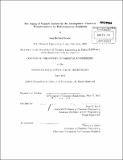| dc.contributor.advisor | Jesse H. Kroll. | en_US |
| dc.contributor.author | Kessler, Sean Herbert | en_US |
| dc.contributor.other | Massachusetts Institute of Technology. Department of Chemical Engineering. | en_US |
| dc.date.accessioned | 2013-10-24T17:43:28Z | |
| dc.date.available | 2013-10-24T17:43:28Z | |
| dc.date.copyright | 2013 | en_US |
| dc.date.issued | 2013 | en_US |
| dc.identifier.uri | http://hdl.handle.net/1721.1/81682 | |
| dc.description | Thesis (Ph. D.)--Massachusetts Institute of Technology, Dept. of Chemical Engineering, 2013. | en_US |
| dc.description | Cataloged from PDF version of thesis. | en_US |
| dc.description | Includes bibliographical references (p. 94-107). | en_US |
| dc.description.abstract | The immense chemical complexity of atmospheric organic particulate matter ("aerosol") has left the general field of condensed-phase atmospheric organic chemistry relatively under-developed when compared with either gas-phase chemistry or the formation of inorganic compounds. In this work, we endeavor to improve the general understanding of the narrow class of oxidation reactions that occur at the interface between the particle surface and the gas-phase. The heterogeneous oxidation of pure erythritol (C4H1 00 4 ) and levoglucosan (C6H1 00 5) particles by hydroxyl radical (OH) was studied first in order to evaluate the effects of atmospheric aging on the mass and chemical composition of atmospheric organic aerosol, particularly that resembling fresh secondary organic aerosol (SOA) and biomass-burning organic aerosol (BBOA). In contrast to what is generally observed for the heterogeneous oxidation of reduced organics, substantial volatilization is observed in both systems. As a continuation of the heterogeneous oxidation experiments, we also measure the kinetics and products of the aging of highly oxidized organic aerosol, in which submicron particles composed of model oxidized organics -- 1,2,3,4-butanetetracarboxylic acid (C8H100 8), citric acid (C6 H8 0 7), tartaric acid (C4H6 0 6 ), and Suwannee River fulvic acid -- were oxidized by gas-phase OH in the same flow reactor, and the masses and elemental composition of the particles were monitored as a function of OH exposure. In contrast to studies of the less-oxidized model systems, particle mass did not decrease significantly with heterogeneous oxidation, although substantial chemical transformations were observed and characterized. Lastly, the immense complexity inherent in the formation of SOA -- due primarily to the large number of oxidation steps and reaction pathways involved -- has limited the detailed understanding of its underlying chemistry. In order to simplify this inherent complexity, we give over the last portion of this thesis to a novel technique for the formation of SOA through the photolysis of gas-phase alkyl iodides, which generates organic peroxy radicals of known structure. In contrast to standard OH-initiated oxidation experiments, photolytically initiated oxidation forms a limited number of products via a single reactive step. The system in which the photolytic SOA is formed is also repurposed as a generator of organic aerosol for input into a secondary reaction chamber, where the organic particles undergo additional aging by the heterogeneous oxidation mechanism already discussed. Particles exiting this reactor are observed to have become more dramatically oxidized than comparable systems containing SOA formed by gas-phase alkanes undergoing "normal" photo-oxidation by OH, suggesting simultaneously the utility of gas-phase precursor photolysis as an effective experimental platform for studying directly the chemistry involved in atmospheric aerosol formation and also the possibility that heterogeneous processes may play a more significant role in the atmosphere than what is predicted from chamber experiments. Consideration is given for the application of these results to larger-scale experiments, models, and conceptual frameworks. | en_US |
| dc.description.statementofresponsibility | by Sean Herbert Kessler. | en_US |
| dc.format.extent | 134 p. | en_US |
| dc.language.iso | eng | en_US |
| dc.publisher | Massachusetts Institute of Technology | en_US |
| dc.rights | M.I.T. theses are protected by
copyright. They may be viewed from this source for any purpose, but
reproduction or distribution in any format is prohibited without written
permission. See provided URL for inquiries about permission. | en_US |
| dc.rights.uri | http://dspace.mit.edu/handle/1721.1/7582 | en_US |
| dc.subject | Chemical Engineering. | en_US |
| dc.title | The aging of organic aerosol in the atmosphere : chemical transformations by heterogeneous oxidation | en_US |
| dc.type | Thesis | en_US |
| dc.description.degree | Ph.D. | en_US |
| dc.contributor.department | Massachusetts Institute of Technology. Department of Chemical Engineering | |
| dc.identifier.oclc | 860793673 | en_US |

